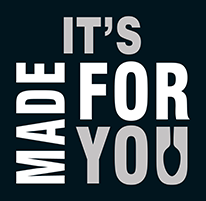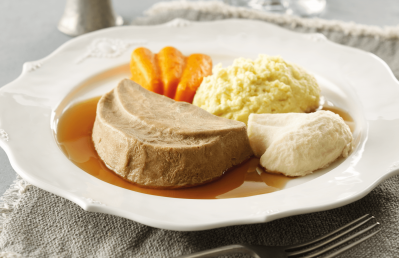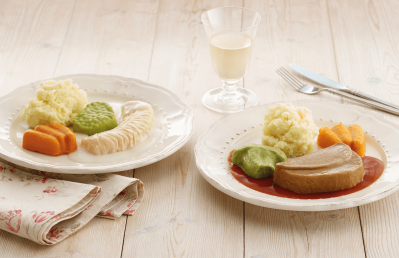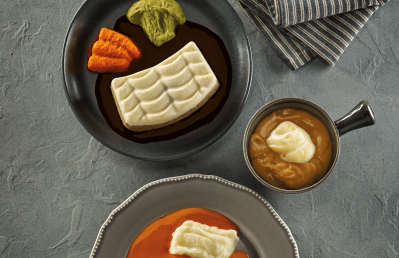-
The word "dysphagia" is derived from the Greek dys meaning bad or disordered, and the root phag- meaning "eat".
-
Dysphagia can affect anyone.
We don't know the exact number of people in the UK who are diagnosed with dysphagia but we do know the prevalence rates amongst certain groups of adults1 and children2.
Who?
How many?
Children with cerebral palsy
31-99%
Children with general neurodevelopmental disabilities
21-44%
Nursing Home Residents
50-75%
Head and Neck Cancer Survivors
50-60%
Stroke Survivors
40-78%
People with MS
31-33%
People with Parkinson's Disease
32%
People with COPD
27%
People with Dementia
13-57%
Adults with a Learning Disability
5%
-
Dysphagia is more common than you think.
Across the world, there are around 590 million people with dysphagia.
How does that compare to other conditions globally?
People with moderate to profound hearing loss – 360 million
People who are blind or have visual impairment– 324 million
People who need a wheelchair – 70 million
-
Depending on the severity of your dysphagia, you can still enjoy nutritious and appetising food.
Speech and language therapists use adapted food (and drink) textures to help people stay safe whilst continuing to enjoy their meals. Their recommendations will refer to the IDDSI Framework, which provides guidance on what consistency and size of bite the food should be.
-
People with dysphagia always cough on their food or drink.
MYTH!
Dysphagia presents in many different ways. Some people have dysphagia but will not cough any more than usual. We all cough on swallowing sometimes!
A cough is when something enters the airway and the body needs to get rid of it quickly. The cough reflex requires that the person can breathe in (if you can breathe in, you're not choking!), there's increased pressure in the throat and lungs as the vocal cords close, then astrong, rapid release of air when the vocal cords open.
In some cases, people's bodies do not detect that food or drink has entered the airway and the cough reflex is absent.
When food or drink enter the airway, this is known as aspiration. When aspiration occurs and there is no cough reflex, this is called silent aspiration. When aspiration results in pneumonia, this is termed aspiration pneumonia.
By working with the person with dysphagia and with other clinicians, the speech and language therapist's role is to detect if dysphagia is present along with silent aspiration as this can cause recurrent chest infections and pneumonias.
-
People who cough on their food and drink will get aspiration pneumonia.
MYTH!
The cough reflex is a natural part of the body's self-defence mechanism. That someone coughs when food or drink goes the wrong way is better than not coughing at all.
However, for some people who have dysphagia and cough on food or drink, as long as it is not too distressing or uncomfortable, it might not matter to them. There are studies that show that some people with dysphagia who are known to aspirate do not get lung infections.
It is the job of the speech and language therapist and multidisciplinary team members supporting the person with dysphagia to consider the possible consequences of aspiration. They make decisions together on how to manage any dysphagia symptoms.
-
Every person with dysphagia needs thickened drinks.
MYTH!
There are some people who experience dysphagia to drinks. This might be because the drink moves too fast for the body to cope and some of it goes the wrong way.
By adding a thickening powder to the drink, it slows its movement through the throat and can give the swallow mechanism time to close off the airway as the swallow happens.
However, not everyone with dysphagia needs thickener. Your speech and language therapist may advise on other options such as water only for a time (as some people won't get a lung infection from aspirated water), enjoying tastes only without swallowing, taking fizzy instead of still drinks, using manoeuvres and strategies or using specialist cups or straws.
If the person with dysphagia benefits from thickener, the speech and language therapist will recommend a consistency as described in the IDDSI Framework. The dosage and directions are always on the thickening powder tin or box.
-
Food and drink is swallowed differently
The way your food and drink are handled by the body varies.
How the dysphagia presents will be the basis for the food and drink recommendations.
Speech and language therapists do a detailed assessment that looks at the underlying impairments, takes into account the person's needs, wishes and preferences, and make recommendations for food and drink using the IDDSI Framework.
-
Mouth care doesn't matter as much if you eat or drink less
MYTH!
Mouth care is important for everyone, including those with dysphagia.
However, people with dysphagia may be at greater risk of poor oral hygiene and health. This is because it might be difficult to clear food or drink from the mouth and bacterial growth can cause pneumonia.
This is also true if the person is nil by mouth. When someone does not eat or drink, the mouth can become dry, uncomfortable, with sore or cracked lips and tongue. This can cause bleeding, and there is also a chance of bacteria forming. Even without food or drink, this bacteria can cause mouth infections or pneumonia.
Regular mouth care is very important and may require additions to a toothbrush and toothpaste such as tongue cleaners and gels to keep the mouth moist and fight off infection.
-
If you have a feeding tube, you can't eat or drink again.
MYTH!
There is a strong relationship between dysphagia and malnutrition.
50% of people with dysphagia due to stroke are malnourished so it is important that a person with dysphagia receives adequate nutrition and hydration.
They may only manage smaller volumes of food or drink or have been recommended a Level 4 puréed diet. This can result in reduced nutrition. For that reason, a feeding tube can provide the extra nutrition or hydration needed. The tube may be temporary or permanent.
Whilst some people remain nil by mouth and have permanent feeding tubes, others eat and drink whilst still using a tube. They may have started ‘oral trials' with the speech and language therapist whilst rehabilitating or be taking food and drink for comfort and quality of life. Or it's simply a combination of a little food and drink with a feeding tube and together they meet the person's needs.
As well as receiving input from a speech and language therapist, the person with dysphagia who needs a feeding tube will have support from a dietitian. A dietitian will assess nutrition and hydration intake and make recommendations.
These may include:
-
Food fortification
-
Oral nutritional supplements
-
Tube feeding
The speech and language therapist and dietitian will work together with the person with dysphagia to ensure adequate nutrition and hydration, safety, and enjoyment of food and/or drink when suitable.
References
-
RCSLT. Giving voice to people with swallowing difficulties. [Online]. Available from: https://www.rcslt.org/-/media/Project/RCSLT/rcslt-dysphagia-factsheet.pdf?la=en&hash=18AEDA640CDABD6D2CAB1A9293E8F44ED4E9572A Accessed: September 2020.
-
RCSLT. Supporting infants, children and young people with feeding and swallowing difficulties [Online]. Available from: https://www.rcslt.org/-/media/Project/RCSLT/rcslt-infant-dysphagia-factsheet.pdf?la=en&hash=03FEAC90757C9B3823CEA9CFCE59B22732BC38FF Accessed: September 2020
-














